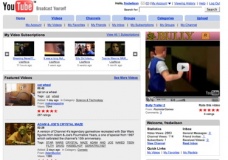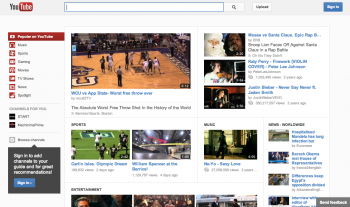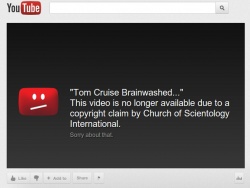YouTube
| Community | Internet Users |
| Membership | Open with email verification |
| Privacy | features that support privacy |
| Self Identity | Profile, Videos, Friends, "Likes" |
| Features | Sharing Photos, likes, comments |
| Status | |
| Launch Date | February 14, 2005 |
| Users | Over a billion users[1] |
Contents
History
YouTube was founded by Chad Hurley, Steve Chen, and Jawed Karim in 2005 to facilitate video sharing. All three were previously employed by PayPal, an online company that acts as a digital wallet for users. YouTube started as an angel-funded enterprise from a makeshift office before receiving a $3.5 million investment from Sequoia Capital in November 2005.[6] When the site began, it had little interface. After receiving this funding, a beta version site was released, which was quickly followed by a real version. During the summer of 2006, YouTube gained popularity and became one of the fastest growing sites on the Web, with users uploading more than 65,000 new videos per day.[7][8] The site continued to grow rapidly and was bought by Google in October 2006 for $1.65 billion[9]. YouTube has gone on to make deals with movie producers as well as television stations to display their content on YouTube. Google+ has also adopted YouTube as its video viewing mechanism.
The NBA agreed to partner with YouTube in 2005 and created its own channel in 2007, recently passing one billion total views. The league, along with many other business organizations worldwide, has made an active effort to make lots of content available to the general public, via YouTube. [10] Youtube and the NBA has also recently made an agreement to make available all of the NBA's Developmental League games footage on Youtube for free.
iPhone Application
In 2012, Apple released iOS 6, the first version of iOS that did not include the YouTube application. At the time, 25% of all YouTube views were on mobile devices. Apple had announced before the release of iOS 6 that YouTube would no longer be pre-installed, and within a month YouTube had created an app of their own. The new application for iOS allows registered users to view channels that they already subscribe to on the main site. It also enables search and share functionality right from the mobile device.[11] This caused issues between Apple and Google, as Google was given limited control of the native YouTube application, most notably the control of advertisements - Apple refused to allow YouTube to display ads before videos.[12] The new advertising potential allows users to view thousands of music videos with advertisements and thus increase their profits significantly. [13]
Youtube Red
In November 2014, Youtube released Youtube Red, which allowed users to access premium content in addition to some extra features. One of the most advertised features was that mobile users could now play videos in the background, even though the application is not open[14]. Although Youtube Red was originally created just for music streaming, it now also includes exclusive television shows and movies such as Scare PewDiePie and Lazer Team. In addition, Youtube Red members also have ad-free access to all Youtube videos. There is a monthly fee for people that want to join Youtube Red, members have to pay a monthly fee of $10. As of March 2016, this service is only available to people within the United States.
YouTube Community
In 2016, YouTube launched its own social-network site within the platform called "YouTube Community" to provide video creators and viewers more ways to connect. Creators can share posts, photos, GIFS, and similar content which viewers can "like" as well as comment on. YouTubers that have already adopted the new feature include John & Hank Green, AsapSCIENCE, The Game Theorists, Karmin, The Key of Awesome, The Kloons, and Lilly Singh.
YouTube TV
YouTube TV is a streaming TV service that allows, for a monthly fee, users to stream Cable and Broadcast channels live, from their computer, mobile device, or select smart televisions and set-top boxes. YouTube TV has a DVR service that allows users to record an unlimited amount of material for later viewing. An internet connection is required to view both live and recorded content. YouTube TV costs $40 / month and allows up to 6 users to have accounts connected to the singular subscription. Additional networks like Showtime, Fox Soccer, and Sundance Now, are available for additional fees. YouTube TV has no additional ads beyond the ones that the TV networks run on their broadcast. [15]
Fame from YouTube
Many young internet stars had their origins in YouTube with a channel that gained millions of views and subscribers. The nature of their videos are comedy, music, pop culture parodies, or beauty tips. Video contests such as Next Up, created by YouTube, gives young artists a platform to showcase their talent and boost the chances of videos going viral. [16] Examples of famous YouTube celebrities are Natalie Tran, Ryan Higa, Ray William Johnson, Mystery Guitar Man, Smosh, Michelle Phan, the ShayTards, Karmin, Jenna Marbles, Freddie Wong, What the Buck, and Philip DeFranco. Many of these stars earn on average $100,000 a year from the videos. Revenue comes from the banners and ads near the video content, sponsored content, and product placement. [17] This brings up the ethical issue of authenticity because it can be hard to determine if the YouTube star genuinely likes a product or if they are only endorsing it because they are being paid to do so. In November 2014, the Advertising Standard's Authority ruled that YouTube "vloggers" (video bloggers) had to make it clear to viewers when they were getting paid to advertise a product or brand, by indicating that it is an advertisement somewhere in the video or video description [18]. By flagging this content as promotional, this will help make it clear to viewers what products the YouTube star naturally promotes versus what products they get paid to promote.
Funding
Similar to Facebook, YouTube is a free website that earns revenue through advertising. Advertisers spend thousands of dollars to have their advertisements featured on top videos. YouTube enforces strict community and technical guidelines for all of its advertisements; the site aims to be fair and consistent with its policies in order to benefit its users, advertisers, and partners. YouTube reserves the right to reject any advertisement from the site that is deemed inappropriate or intrusive, and refunds are not issued for promotions in which the related advertisements disabled, or suspended due to policy violations.[19]
Copyright Concerns
YouTube faces many copyright issues because it does not monitor the content of videos. Section 6-D of YouTube's terms of service states, "You further agree that Content you submit to the Service will not contain third party copyrighted material, or material that is subject to other third party proprietary rights, unless you have permission from the rightful owner of the material or you are otherwise legally entitled to post the material and to grant YouTube all of the license rights granted herein." However, this does not always deter users from uploading copyrighted material. Despite the fact that millions of videos on YouTube are violating copyright, YouTube does not remove the videos and makes little to no effort to enforce its copyright policies unless a user or company specifically brings an issue to their attention.
For the past five years, there has been an ongoing lawsuit between YouTube and Viacom. Viacom claimed that YouTube failed to remove copyrighted material, such as "The Daily Show With Jon Stewart" from the site. On April 4, 2012, it was decided that this was a violation of copyright, but the two companies arranged a deal in which YouTube can allow users to rent Viacom's Paramount Pictures movies[20].
Third-Party Claims
Youtube has incorporated a set of content-identifying tools which third-party companies who have a commercial partnership with Youtube can use to search for videos matching their content. This is usually how copyrighted videos are found and removed.
Ethical Issues
Controversial Content
Using the definitions established by Youtube to help define "controversial content," there is a lot of controversial content that can be found on the site. The following guidelines are taken from the site, and these guidelines state:[21]
- YouTube is not for pornography or sexually explicit content. If this describes your video, even if it's a video of yourself, don't post it on YouTube. Also, be advised that we work closely with law enforcement and we report child exploitation. Please read our Safety Center and stay safe on YouTube.
- Don't post videos showing bad stuff like animal abuse, drug abuse, under-age drinking, and smoking, or bomb making.
- Graphic or gratuitous violence is not allowed. If your video shows someone being physically hurt, attacked, or humiliated, don't post it.
- YouTube is not a shock site. Don't post gross-out videos of accidents, dead bodies or similar things intended to shock or disgust.
- Respect copyright. Only upload videos that you made or that you are authorized to use. This means don't upload videos you didn't make or use content in your videos that someone else owns the copyright to, such as music tracks, snippets of copyrighted programs, or videos made by other users, without necessary authorizations. Read our Copyright Tips for more information.
- We encourage free speech and defend everyone's right to express unpopular points of view. But we don't permit hate speech (speech which attacks or demeans a group based on race or ethnic origin, religion, disability, gender, age, veteran status, and sexual orientation/gender identity).
- Things like predatory behavior, stalking, threats, harassment, intimidation, invading privacy, revealing other people’s personal information, and inciting others to commit violent acts or to violate the Terms of Use are taken very seriously. Anyone caught doing these things may be permanently banned from YouTube.
- Everyone hates spam. Don’t create misleading descriptions, tags, titles or thumbnails in order to increase views. It's not okay to post large amounts of untargeted, unwanted or repetitive content, including comments and private messages.
If a user finds a video in violation of any of these rules, they can flag the video to be reviewed by Youtube staff. If the video is found by the staff to be in violation of the guidelines, staff members can then order for the video to be taken down. YouTube claims that it has a team of employees who are completely devoted to enforcing these guidelines on all of the site's uploaded content. However, because of the sheer volume of content that is constantly being uploaded onto Youtube, this is a very difficult task for any number of people. Utilizing a "Content ID" system, which allows content creators to upload their work to a database so that future uploads are automatically compared to the files in the database to scan for any copyright violations or any other misuse of content, Youtube has partnered with over 8,000 organizations to automatically check if videos have infringed on any sort of copyrighted content. [22]
Restricted Mode
YouTube introduced a new Restricted Mode in March 2017, which uses "signals—such as video title, description, metadata, Community Guidelines reviews, and age-restrictions—to identify and filter out potentially mature content"[23] The purpose of the feature is to allow users to avoid mature or inappropriate content that they don't wish to view. This restricted mode can be turned off in YouTube's settings by users. However, the site faced a backlash from the LGBTQ+ community after it became apparent that Restricted Mode blocked all videos with the words "gay", "lesbian", "bisexual", or "transgender" in the title, regardless of the content contained inside the actual video, even if the videos were created for educational purposes and contained no mature content. [24] In a statement released shortly after the implementation of Restricted Mode, YouTube announced that the filters would not block all LGBTQ+ content, but would target "only those that discussed delicate topics such as politics, health, and sexuality". [25] A Twitter user named Rezulux challenged this statement by uploading two identical videos, titled "this is a video" and "this is a gay video", and demonstrated that the latter video was blocked in filtered mode, while the first video was not. [26]
Many LGBTQ+ YouTube personalities have spoken out about the controversy, saying that they worry about the effect that the censorship might have on LGBTQ+ youth who use YouTube as a source of community. According to YouTube star NeonFiona, "Kids who want to know about different orientations and definitions and about the history of LGBT people, etc, they can’t access that when their videos are being restricted. Restricting these videos makes it harder for these kids to find the information they need and the community that they’ve been missing.” [27] Another YouTube personality, Rowan Ellis, believes that the system, by virtue of banning any mention of issues affecting the LGBTQ+ community, inherently implies that LGBTQ+ content is automatically not family friendly, which will have a negative impact on societal attitudes towards LGBTQ+ individuals regardless of whether it was intentional on YouTube's part. [22]
One day after their initial statement, YouTube released an official apology, stating that they had lifted the restrictions on several incorrectly labeled videos. Additionally, the streaming company promised to change their algorithms to correct this behavior so future videos would not be flagged or removed simply for including information pertaining to LGBTQ+ issues in the title. [28]
Anonymity
Many have claimed that it is difficult to control behavior on YouTube because, as a result of the ability to adopt "screen names" in place of using actual names, identification of users is voluntary. This anonymity means users are often more comfortable using things like YouTube to MP3 Converters, which can be used to download songs from YouTube videos to a user's computer. There are also similar programs which allow users to download videos from the site. [29] Additionally, because it is relatively easy to set up a YouTube account, users that have been banned from the site for violating the terms of service often make new accounts to continue using the site.
Comments
The YouTube comments section has no censorship, which means that there is the potential for derogatory or offensive content to be posted by other members of the community. This allows YouTube to be a space where cyberbullying and incivility is present in the comments. As mentioned above, because YouTube is a mostly anonymous environment, it is difficult for YouTube moderators to properly punish users, which would presumably be conducted by tracking them down and censoring the users who post harmful or offensive material. YouTube does allow users to mark comments as spam, and also gives them the option to give negative votes. If an individual comment is marked as spam, or negatively voted too many times, it does not show up by default and has to be clicked on before viewing. YouTube allows the user to enable or disable video comments if the user feels that they are being treated unfairly, or if they simply do not want others to offer their thoughts on whatever content was uploaded.[30] There is, however, a strong community moderation of YouTube comments, where users can flag comments as spam or down vote certain comments. Comments with enough downvotes will receive the label "This comment has received too many negative votes" and users will have to click "show the comment" to be able to view it, similar to the process outlined above.
Benefit
Anonymity can allow YouTube users to contribute to the site more freely without worrying about the release of their personal information, which can allow for more open discussions and limits the threat of retribution or retaliation from users who disagree.
Harm
Anonymity allows users to post content that might be offensive or inappropriate to other users. YouTube administrators can effectively ban an account, but not necessarily a user since there are no mechanisms in place to prevent a person from creating another YouTube account, as this would be nearly impossible to do. In many instances, due to the relative ease of opening an account on Youtube, the owner of a banned account can simply create a new one using the same computer as before. In rare cases, if a user's content is strongly incriminating, steps can be taken to identify the user in the real world and seek legal action. One example of this can be seen in the case of Dusty the Cat, which was a Facebook user posting videos of himself abusing an animal anonymously.
Content Theft
With the rise in popularity of the streaming platform Twitch.tv, content creators have begun to make video compilations of popular streamers, often without their consent. Many Twitch streamers complain that their content is being stolen and used to create clickbait titles that abuse human characteristics to encourage people to click the video. These youtubers argue that they are creating new content by conglomerating multi-hour streams that are hard to watch all the way through. While there are some Youtube creators who are respected by Twitch streamers, others are part of an ongoing copyright debate.
ContentID: Piracy and its Prevention
Issues of copyright infringement are prevalent in Youtube videos. Copyrighted material is often uploaded without the owner's permission. The fact that anyone can upload anything to YouTube is an issue. This can include adult content, gruesome videos, and other outlandish videos. It is possible to keep the videos uploaded so even if they are removed later on, copyright violations have already been done. People can also post knowledge materials such as science from a textbook for free, and use YouTube for free advertising without having to pay for it. This can be construed as copyright infringement. To combat this, YouTube has taken steps to ensure that copyrighted content is removed, including supplying copyright infringement notifications for third-party users.[31]
ContentID was created in order to reference previously flagged copyright infringing videos. Once a video is uploaded to the site, it is compared to copyrighted materials to see if the content is an infringement. If an uploaded video is matched correctly to a copyrighted video, the owners can choose to "monetize, track, or block" the content.[32] There is no cost of using this system. In order to use it, a form from YouTube's website is filled out. [33]
However, the ContentID system can also cause harm to users who post non-infringing content. For example, bird chirps and motorcycle engines have been known to be identified by the system as copyrighted content on occasion.[34] NASA's public domain broadcasts have also been frequently removed following take-down requests from news services that rebroadcast their material.[35]
Blocking of YouTube
Several countries have blocked YouTube at one point because of its controversial content. Due to the offensive content being published, some countries have actually allowed very censored content to be shown to the public instead of getting rid of the site as a whole. Ranging from sexual scandals to political conflicts, some countries that have banned YouTube include:
- Afghanistan
- Armenia
- Bangladesh
- Brazil
- China
- Indonesia
- Iran
- Libya
- Morocco
- North Korea
- Pakistan
- Russia
- Syria
- Sudan
- Thailand
- Tunisia
- Turkey
- Turkmenistan
- United Arab Emirates
- United Kingdom
- Venezuela
See Also
External Links
References
- ↑ YouTube, YouTube, www.youtube.com/yt/press/statistics.html.
- ↑ Alexa Top Sites | http://www.alexa.com/topsites
- ↑ Youtube | http://en.wikipedia.org/wiki/Youtube
- ↑ Goldman, D. (2015). “Google will become Alphabet today”. CNN Money. http://money.cnn.com/2015/10/02/technology/google-alphabet/
- ↑ "Google says one hour of video is now being uploaded to YouTube every second" (30 January 2012. Retrieved on 23 April 2017.)
- ↑ Woolley, Scott · (2006-03-13) · Raw and Random · Forbes.com · Forbes · 2006-07-28
- ↑ Youtube History
- ↑ lastname, firstname · (July 16, 2006) · YouTube serves up 100 million videos a day online · USA Today · November 29, 2008
- ↑ YouTube CrunchBase
- ↑ ESPN article on the NBA's YouTube channel views http://espn.go.com/blog/playbook/tech/post/_/id/3260/nba-surpasses-1-billion-views-on-youtube
- ↑ Chmielewski, Dawn C. “YouTube Launches New Mobile App for Apple's IPhone.” Los Angeles Times, Los Angeles Times, 11 Sept. 2012, articles.latimes.com/2012/sep/11/news/la-youtube-launches-new-mobile-app-for-apples-iphone-20120911.
- ↑ Kelly, Heather. "YouTube releases new iPhone app" 11 September 2012. Retrieved on 23 April 2017.
- ↑ Chmielewski, Dawn. "YouTube launches new mobile app for Apple's iPhone" (11 September 2012. Retrieved on 23 April 2017.)
- ↑ https://en.wikipedia.org/wiki/YouTube_Red
- ↑ YouTube TV - Watch & DVR Live Sports, Shows & News. (n.d.). Retrieved April 19, 2018, from https://tv.youtube.com/welcome/
- ↑ New York Times. "On YouTube, Amateur Is the New Pro" "http://www.nytimes.com/2012/07/01/magazine/on-youtube-amateur-is-the-new-pro.html?pagewanted=all&_r=0"
- ↑ Business Insider. "Rich Youtube Stars" "http://www.businessinsider.com/meet-the-richest-independent-youtube-stars-2010-8?op=1"
- ↑ Morris, Ian. "YouTube Stars In The UK Warned About Advertising Products In Videos" (19 August 2015. Retrieved on 23 April 2017.)
- ↑ YouTube Advertising Policies
- ↑ http://topics.nytimes.com/top/news/business/companies/youtube/index.html
- ↑ http://www.youtube.com/t/community_guidelines
- ↑ 22.0 22.1 MUD. "Why Your Favorite Video Just Disappeared from Youtube" https://www.makeuseof.com/tag/favorite-video-disappeared-youtube/
- ↑ YouTube Help. "Enable or Disable Restricted Mode" https://support.google.com/youtube/answer/174084?hl=en
- ↑ Gizmodo. "YouTube's Restricted Mode is Hiding Some LGBT Content". http://gizmodo.com/youtubes-restricted-mode-is-hiding-some-lgbt-content-1793382337
- ↑ The New York Times. "YouTube Filtering Draws Ire of Gay and Transgender Creators" https://www.nytimes.com/2017/03/20/technology/youtube-lgbt-videos.html?_r=0
- ↑ The Los Angeles Loyolan. "YouTube losing advertisers after LGTBQ+ and racism incidents' http://www.laloyolan.com/news/youtube-losing-advertisers-after-lgtbq-and-racism-incidents/article_4f3b0f9b-9ac5-5d13-a0f4-a95c1d77b9f8.html
- ↑ Pink News. "YouTube’s ‘restricted mode’ is hiding LGBT content from viewers" http://www.pinknews.co.uk/2017/03/17/youtubes-restricted-mode-is-hiding-lgbt-content-from-viewers/
- ↑ Yahoo News. "YouTube issues a proper apology over restricted mode censoring creators" https://www.yahoo.com/news/youtube-issues-proper-apology-over-072607174.html
- ↑ http://www.youtube-mp3.org/
- ↑ http://support.google.com/youtube/bin/answer.py?hl=en&answer=58123
- ↑ http://www.youtube.com/t/copyright_center
- ↑ http://www.youtube.com/t/contentid
- ↑ http://www.youtube.com/content_id_signup
- ↑ Messieh, Nancy. “YouTube's Automated Copyright System Triggered by Chirping Birds.” The Next Web, 27 Feb. 2012, thenextweb.com/google/2012/02/27/a-copyright-claim-on-chirping-birds-highlights-the-flaws-of-youtubes-automated-system/.
- ↑ “Curiosity's Mars Landing Video Disappears From YouTube Due To Bogus Copyright Claim.” Techdirt., www.techdirt.com/articles/20120806/11053019945/curiositys-mars-landing-video-disappears-youtube-due-to-bogus-copyright-claim.shtml.




